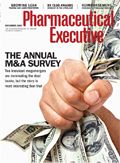Time to Step Up
Pharmaceutical Executive
The economy is turning around; leaders need to position their companies now for the market bounce.
Weak economic indicators and tepid earnings reports can seem daunting to corporate chieftains and their direct reports. But there are valid and compelling reasons to believe that the long-awaited upturn is coming, and if you can hang on without making deep cuts to staff or losing too much market share, your employees, customers, and stakeholders will reward you during the rebound.

Sander A. Flaum
Which, in fact, has already begun. In September, Federal Reserve Chairman Ben Bernanke said, "From a technical perspective, the recession is very likely over." He added that although the job market remains weak, there is a broad consensus that we are in a recovery.
The question is, how much further do we have to go, and what can we do until we get there? Here's a quick survey of some bullish economic trends and what they mean for today's business leaders.
Profits are Coming Back
After a steep drop, American business is back in the black. For the past two quarters, corporate profits have been on the rise, according to the Bureau of Economic Analysis. Meanwhile, the Commerce Department projects that businesses will bring in nearly $1.3 trillion in profits this year—well above the annual rate estimated during the fourth quarter of 2008.
Business leaders should show those figures to skeptical employees as evidence of a turnaround. Employees are not always attuned to the broader economy, and the mood around the office has more to do with the specific conditions of the labor market, such as direct pressure on salaries, workloads, and benefits. Unfortunately, the job market remains weak and is trailing the broader recovery, so it is incumbent upon managers to remind anxious employees that business is improving.
When an NDA is filed, when a new product is launched, or if your firm lands a big account, share the news quickly. If a client expands an order, spring for lunch. Remind your staffers that they are a part of the rosier picture.
Consumer Confidence Remains Elevated
Consumer spending represents two-thirds of the gross domestic product in the US, so reopening the American wallet is critical to a return to economic growth. The good news is that the Gallup Consumer Confidence Index rose to a reading of minus-20 for the week ending September 27—that's up 40 points from the same period a year ago and its highest level in 21 months.
What can leaders take away from this data? Broadly, they can justify bolder decisions about their supply chains and inventory, predicated on the idea that demand is coming back. Managers can afford to tinker a little with their tactics. Maybe it's a marketing push to a new segment. Maybe it's a strategy that includes broader distribution. Go ahead: take some risks.
Credit is Thawing
Capital markets froze last winter after Lehman's fall, but deals have picked up again in recent months and the lending environment is improving for small businesses. According to the Small Business Administration, the average weekly loan volume in federal 7(a) business loans rose sharply from March to September. At the same time, banks have increased their mailings of credit card offers to business owners.
For managers, this means it's time to start thinking BIG again. Growth plans might be within the realm of possibility. At the very least, these signs suggest leaders should begin to prepare for when funding is more widely available. Have an idea that costs money? Draw up a prospectus, and take it to the CFO and CEO. You might be surprised by who says "yes."
Innovation persists
In September, Ford Motor Company drew back the curtains on Figo, the auto giant's first compact to be produced in India. Starbucks began selling instant coffee across the country. As of this writing, Microsoft is on track to launch Windows 7 before Halloween. While other companies merely cut costs to appease investors, these firms held fast to the development of new products. Now those investments are paying dividends in the form of new revenue streams.
Managers would be wise to take a cue from these companies. Don't pare back research budgets. Keep innovating, or launch an innovation procedure within the company, and you'll position your firm for a big bounce when market indicators turn around.
And that's going to happen sooner rather than later.
Sander A. Flaum is managing partner of Flaum Partners and chairman, Fordham Graduate School of Business, Leadership Forum. He can be reached at sflaum@flaumpartners.com
